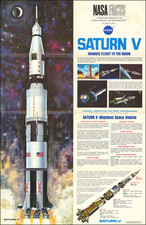Apollo Mission 16 Lunar Photography Index Map: Sheet 2 of 6, published by the Defense Mapping Agency Aerospace Center for the National Aeronautics and Space Administration in August 1972, provides a comprehensive record of the photographic outputs from the Apollo 16 mission's mapping camera. This particular sheet, the second of a six-part series, catalogues specific revolution frames that were captured during various orbits of the lunar module around the Moon, with each color denotation representing a different set of frames taken during distinct revolutions.
The late 1960s and early 1970s marked a pivotal moment in human history when, under the aegis of NASA, astronauts ventured beyond Earth's bounds to explore the Moon. The Apollo missions were underpinned by robust scientific endeavors to study our satellite, with photography playing a crucial role in both reconnaissance and research. These photographs, therefore, were not mere mementos of human achievement but pivotal tools for geospatial study, lunar geology, and the planning of subsequent lunar landings.
The precision of the mapping camera is evident from the technical details provided: a focal length of 3 inches and film specifications indicating a 4½"x4½" image on 5-inch 3400 B&W film. The detailed indexation – distinguishing between different orbital revolutions with color-coded denotations – underscores the meticulous planning and execution of the mission's photographic agenda. Annotations pertaining to the orbital altitude, sun elevation, camera tilt, and azimuth angles, among other particulars, have been diligently compiled by the Mapping Sciences Branch at NASA's Manned Spacecraft Center in Houston, Texas.
Published by the Defense Mapping Agency Aerospace Center in St. Louis, Missouri, this document stands as a testament to the collaborative efforts of various institutions and individuals in ensuring the success of the Apollo program. The lithographic method employed further speaks to the technological capacities of the time, merging artistry with precision to create a lasting record of a groundbreaking mission.
The Apollo 16 mission, launched on April 16, 1972, was the tenth crewed mission in NASA's Apollo space program and the fifth to successfully land humans on the Moon. Commanded by astronaut John Young, with Charles Duke serving as Lunar Module Pilot and Thomas Mattingly as Command Module Pilot, Apollo 16 spent over 71 hours on the lunar surface, primarily in the Descartes Highlands. This mission marked the first time astronauts explored the highlands area, collecting over 200 pounds of lunar samples for analysis back on Earth. Apollo 16, as a critical part of the broader Apollo program, contributed significantly to our understanding of lunar geology and paved the way for future manned space exploration.













![[ Walking on the Moon -- Apollo 15 Extra Vehicular Activity Atlas ] Hadley-Apennine Landing Site Apollo 15 - 1:12,500 and 1:25,000](https://storage.googleapis.com/raremaps/img/small/68099.jpg)

![[French-Russian Soyuz T-6 Flight Poster] Советско-Французский Космический Полет 1982](https://storage.googleapis.com/raremaps/img/small/68336.jpg)
![Apollo Earth Orbit Chart (AEO) Apollo Mission 8. Sheet 1 of 3, Contains Revolution 1. For December 1968 Launch Dates [with:] Sheet 2 of 3, Contains Revolution 2. For December 1968 Launch Dates [and: Sheet 3 of 3, Contains Revolution 3. For December 1968 Launch Dates]](https://storage.googleapis.com/raremaps/img/small/95707.jpg)